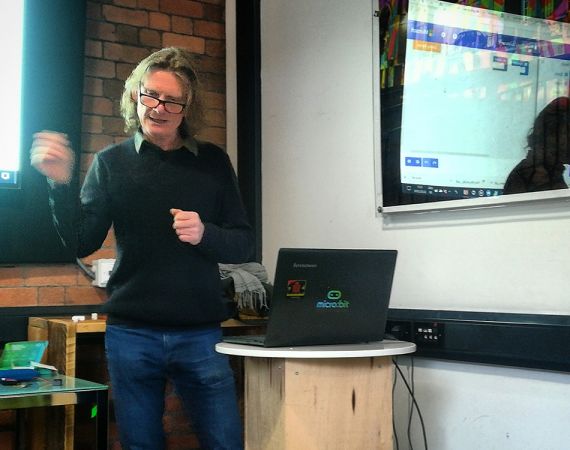Lunchtime talk write-up
Posted on Fri 6 Apr 2018
BBC Micro:bit - for writing the future
After 17 years at the BBC, guest speaker Howard Baker now works with the Micro:bit Foundation. The Micro:bit is a small programmable device, a bit like a portable computer. The project started life in 2013, and was officially launched in October 2015. It was developed by BBC Learning with the help…

Posted by
Speaker
Howard Baker
Howard Baker is Head of Academic and Marketing Research and Audiences for the Micro:bit Educational Foundation. He worked at the BBC for 17 years where he created the BBC micro:bit project. Previously, Howard has worked in academic and commercial research, run his own successful fashion design business and worked as a teacher and journalist.96
Normal
0
false
false
false
EN-GB
X-NONE
X-NONE
/* Style Definitions */
table.MsoNormalTable
{mso-style-name:"Table Normal";
mso-tstyle-rowband-size:0;
mso-tstyle-colband-size:0;
mso-style-noshow:yes;
mso-style-priority:99;
mso-style-parent:"";
mso-padding-alt:0cm 5.4pt 0cm 5.4pt;
mso-para-margin:0cm;
mso-para-margin-bottom:.0001pt;
mso-pagination:widow-orphan;
font-size:12.0pt;
font-family:"Calibri",sans-serif;
mso-ascii-font-family:Calibri;
mso-ascii-theme-font:minor-latin;
mso-hansi-font-family:Calibri;
mso-hansi-theme-font:minor-latin;
mso-ansi-language:EN-GB;}
After 17 years at the BBC, guest speaker Howard Baker now works with the Micro:bit Foundation. The Micro:bit is a small programmable device, a bit like a portable computer. The project started life in 2013, and was officially launched in October 2015. It was developed by BBC Learning with the help of BBC R&D and has been the BBC’s most ambitious educational project to date.
Five things I Learned:
1. The initiative began when it became apparent that there was a knowledge gap between children and the technology they engage with, the aim was to teach kids how to code and turn consumers into creators. The problem is that most people don’t have access to the tools needed to learn to code, therefore the Micro:bit was born to inspire a generation. The challenge was trying to create something that cost less than £2 per unit that was fun and easy to use, but not disposable.
2. Through working with 29 different partners, who donated chips, money, expertise and time, they were able to add way more functionality to the device than first conceived and in the summer of 2016 the device launched to thousands of children. The response was hugely positively and the BBC decided that the project should continue on in a different capacity, therefor the Micro:bit Education Foundation was born. The device is now available in 50 countries, the website has been translated into 17 languages and now has 132 partners globally.
3. The board features two programmable buttons, an accelerometer to detect movement, a compass to detect what way it is facing, a light and temperature sensor, as well as a LED screen. It can talk to smartphones using Bluetooth allowing them to instruct each other or it can be connected to a computer through a USB port. The accompanying Micro:bit website is an extremely important resource as it gives access to hundreds of tutorials for programming, editors and ‘block code’ meaning you can easily drag and drop code into the Micro:bit to make it do all sorts of things.
4. The Micro:bit can be coded using a tablet as it is browser-based and includes an emulator (meaning you don’t need to plug the Micro:bit into tablet). You can attach additional sensors to the board, like a set of toy wheels for example. The device utilises the internet of things, it’s all about connecting smart objects together and gives opportunity for kids to think about what the future of smart objects might look like.
5. After the reports they talked to experts, teachers and kids at MadLab in Manchester Howard realised hacking and making was becoming more mainstream, with more and more kids getting interested. Is it more about being creative rather than learning code? They took a different approach, kids just want to make exciting projects and in fact, learning to code is the side effect.
10 Micro:bits have been donated to the studio and Howard is looking to see residents using them in creative ways!
